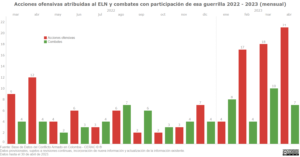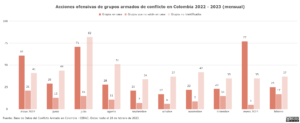Published on December 15, 2014 in International Political Forum
After two weeks of captivity, Colombia’s general Alzate was freed by the country’s biggest guerrilla group, the Revolutionary Armed Forces of Colombia (FARC) on Sunday, November 30. How will his release shape Colombia’s peace process?
Over a week has passed since the release of Colombian General Dario Rubén Alzate, the military official kidnapped by the FARC on November 16 in La Mercedes, a small municipality of the country’s northern Chocó state, and freed two weeks later, on November 30.
Alzate had been the first ever general to be captured by the guerrillas. His kidnapping reasserted the strength of the FARC which, since the mid-1960s, have been threatening the country’s stability. But, most worryingly, it also halted the peace process that Colombia’s President Juan Manuel Santos has been carrying out with the FARC over the past two years.
Few hours after the General’s capture, Santos stated that, so long as Alzate remained in the FARC’s hands, talks would not resume. The peace process, which government and guerrillas have begun on August 26th 2012 on the basis of a 6-points agenda to be discussed by the two delegations in la Habana, Cuba, was thus effectively frozen.
On Sunday, November 30, after a few days of secret negotiations between government and guerrillas, Alzate was handed over, together with two other captives, to representatives of the International Red Cross and the two guarantor nations of the peace process, Norway and Cuba. A video taken by the guerrillas shows FARC leader Pastor Alape reaching Chocó to free the General and the two other prisoners. The footage stirred up a hornet’s nest: Alape, one of the key FARC delegates in La Habana, is shown listening carefully to the captives’ stories, discussing matters with Alzate, and finally taking a picture with the General, with the latter smiling at the camera.
A much-needed explanation
A day after his release, Santos claimed Alzate owed his country some explanations. Just what exactly was the General doing that morning in Chocó? How could he wander into a red zone, known to be heavily controlled by guerrillas, accompanied only by another military official and a human rights lawyer, both captured with him the same day? And why was he visiting the municipality wearing civilian clothes?
Alzate spoke publicly on the evening of Monday, December 1, to answer the above. He claimed he had been victim of the FARC’s media-circus, and was forced to pose next to the guerrilla leader. He said he had travelled to La Mercedes to oversee the implementation of a development project that aimed to eradicate the municipality’s structural poverty. He added that he chose to wear civilian clothes in the aim of strengthening a sense of trust with the local community. And he offered his resignation to President Santos, for the damage that his misconduct had caused the army.
That same evening, Santos accepted the General’s resignation, and allowed the government’s delegates toreturn to Cuba. FARC representatives and government officials declared the crisis to be over, and announced that the next dialogue sessions would take place between December 10 and December 16.
But what exactly will be the consequences of Alzate’s release? How have the events of the past few weeks shaped the peace process between the government and guerrillas? Somewhat paradoxically, the feeling is that Alzate’s crisis could have somewhat strengthened the prospects of the peace process.
The FARC’s evolution?
To some extent, the General’s release would appear to have boosted the credibility of the FARC as a partner in the negotiations. Contrary to the image of a fractured, unorganised body that operated somewhat independently of the steps taken by its delegation in Cuba, the guerrillas have proven to be capable of acting in a coherent fashion. The Frente 34, the battalion that captured Alzate, complied with the decision taken by the FARC’s highest cadres and cooperated with them in freeing the three captives. And this ran against the fears of those who thought that, independently of the decisions taken in la Habana, the FARC’s Council would have little control over its many groups deployed all throughout Colombian soil.
On a much more general level, the General’s release would seem to flesh out a certain evolution in the FARC’s relationship with Colombia’s central government. For all the questions it leaves unanswered, the significance of Alzate’s liberation cannot be underestimated. The guerrillas willingly freed the highest-ranking military official they ever held captive, and did so conscious of the effects which the event would have for the talks in Cuba. Contrary to the much more confrontational attitude they had taken up against the previous peace talks under former Presidents Betancur (1982-86) and Pastrana (1998-2002), the stances taken before Santos’ administration seem to point to a more cooperative relationship between the two sides.
This is not to romanticise the FARC’s allegedly new approach to the peace process. At the time of writing, clashes between government and guerrillas are still undergoing, and violence on Colombian soil is far from being eradicated. The footage of the captives’ release ingeniously presents the guerrillas under a very different light. Pastor Alape is himself portrayed as a friendly face discussing the importance of development for Colombia’s rural population, so much so that, more than a guerrilla leader, the FARC delegate looks like an anthropologist on a field trip.
The propaganda is no coincidence: with the prospects of an agreement approaching soon, the FARC must try to present a clean face in front of the country. And this is all the more crucial when understood in light of the guerrillas’ intention to hold a general referendum and request amnesty for their crimes, once the negotiations come to a close. But the efforts only work up to a point. People’s outcry against Alzate’s picture with Pastor Alape is, in this sense, very telling. It is one thing to foster one’s credibility before other delegates in Cuba – quite another to regain legitimacy before the people who’ve been affected by this conflict for the past 60 years.
Dialogue rebooted
On the other hand, Alzate’s release was an important reboot for Santos’ strategies. The liberation, inasmuch as it was carried out through negotiations with the guerrillas, can now be heralded by the government as further evidence of the importance of dialogue as the chief means to end the conflict.
For Santos, this is no small victory. His government is, at once, engaged with a war against the FARC and an internal struggle inside the parliament, where the opposition led by his predecessor Alvaro Uribe has attacked the President’s strategy as damaging the country’s security. To put it bluntly, peace cannot be negotiated: it can only be won on a military level. What Santos is doing is a dangerous game that’s jeopardising Colombia’s stability.
Seen from this angle, Alzate’s release is a much-needed breath of fresh air for Santos’ administration. The President’s approval ratings had dropped from a 60% in September to a current 45%. It is hard to guess to what extent the peaceful ending of last week’s crisis will reverse this trend, but Santos now has the opportunity to make the most of the events and defend his policies before the country.
But if it is true that peace can be won on a political level, then Santos must show this is the case to the people he represents, not simply the politicians he is up against. And this is not an easy task. Just like the guerrillas, the government must try to regain credibility before its people. For Santos, the challenge will be to overcome the dichotomy upon which the whole peace process problematically lies. For the President is, at once, talking peace in Cuba, while waging war in Colombian soil. If Alzate’s allegedly forced smile next to Pastor Alape caused so much controversy, then much of people’s anger owes precisely to this point. It is hard to understand how a guerrilla group that is dealt with as a terrorist organisation at home can be treated in a statesman-like fashion abroad, much less how a military General would smile next to one of its leaders.
And yet that picture may embody the embryonic stage of a new step in Colombia’s peace process. If it is true that one of the agreement’s six points includes the reintegration of the guerrillas in civil life, then for all the doubts surrounding Alzate’s kidnapping, his face next to Pastor Alape is a symbol of what will come next. The General’s release can lead to a significant strengthening of the peace talks between guerrillas and government. It can, and did, reassert the importance of dialogue as the single mechanism to reach a durable agreement between the two sides.
But peace cannot remain something abstract, standing over and above the people it is meant to benefit. To make sure Cuba’s resolutions will turn into something that will effectively trickle down to the polity, Santos must first find a solution to the internal conflict that is still unfolding inside Colombian soil. And this entails a ceasefire between the State and the FARC.
To be sure, the strategy carries a number of risks. A ceasefire may lead to a significant strengthening of the military capacities of the guerrillas, or even deteriorate the entire peace process, as it did under Betancur and Pastrana’s administrations. But whether the pact will take the form of a bilateral agreement, or (much less likely) a unilateral deal on the part of the FARC, a cogent peace process cannot be premised on two different languages, peace and war, unfolding at the same time. If Santos wants to be coherent with his rhetoric, then a ceasefire is a step his government must make. After Alzate’s kidnapping, this will be the next crucial test for Colombia’s peace process.


